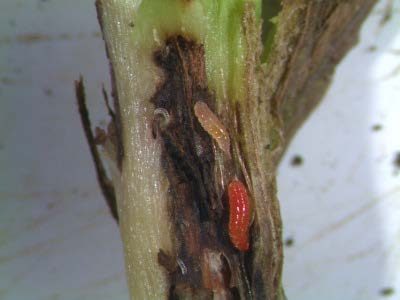
Significant yield loss was reported on the edge of many midge-infested fields during the 2018 growing season. Although it could be found on the edges of several soybean fields in 2020, damage didn’t appear to be as widespread or severe in Iowa. However, Nebraska reported quite a bit of damage in 2020. Yield loss estimates on a small sample of plants from a heavily damaged field indicate complete yield losses from the field edge up to 100 feet, with about 20% yield loss 200 and 400 feet from the field edge.

A lot of research has been conducted in Iowa, Nebraska, and Minnesota over the last few years to better understand this pest and attempt to identify management practices to reduce yield loss. So far, no fully-effective treatment option exists, although several are being evaluated. Soybean gall midges overwinter in the pupa stage, mostly located within a couple of inches of the soil surface. Adult emergence traps show that overwintering midge adults are coming from where beans were grown the previous year. One study is looking at doing fall tillage in that area with mixed and minimal positive results so far. Mowing the field border just before emergence of adults has also been tried—again, with limited positive results to-date.

The overwintering larvae have begun to emerge from the soil around the 10th to 14th of June the last two years. Emergence of this generation has extended over 25 days on average. Several foliar application trials have been conducted to see if this would reduce the damage, including a trial I have conducted in Plymouth County the last two years. Success from foliar insecticides has been very limited which, I believe, is due to the long time period that these insects emerge and that the eggs are laid in the cracked lower stems of soybeans, keeping them from getting direct exposure to insecticide applications. Other evaluations that are ongoing are several seed treatments and sorting through hundreds of genetic lines looking for signs of resistance. So far, a little positive news—but not much. One treatment showing some promise is the use of Thimet insecticide T-banded at planting time. It is labeled for use in soybean, and, at a couple of sites, it has shown a reduction of injured plants and increased yield. A site at Dordt near Sioux Center showed a positive response, but a site at the NW Research Farm was more mixed. Since injury is often much worse at the field edge, I might consider trying it on the end rows adjacent to where soybeans with damage were found the year before.
To learn more about this pest, consider going to the Midwest clearinghouse at https://soybeangallmidge.org/. Great scouting hints can be found there along with three recordings from January discussing a lot more current knowledge of this pest. That series featured university extension specialists from our nearby states. For other questions, please visit with your local agronomist or contact me at the Plymouth County Extension Office.
Article Written By: Joel DeJong - Field Agronomist with Iowa State University Extension & Outreach